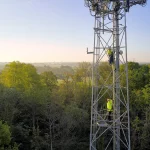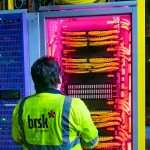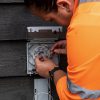2018 H2 – UK Superfast Broadband Coverage Slowly Edges to 96%
A new independent model has estimated that the coverage of fixed “superfast broadband” (24Mbps+) ISP networks across the United Kingdom has grown to 95.8% at the end of 2018 (up from 95.3% in H1 2018), while “full fibre” (FTTP/H) networks now reach 5.47% of premises (up from 3.82% in H1).
Officially the first 76% of “superfast” network coverage was largely achieved by purely commercial roll-outs from Openreach (BT) and Virgin Media (plus some alternative network ISPs), while much of the final 25-30% has benefited from £1.6bn+ of public funding via the Broadband Delivery UK programme (matched by contributions from private operators) and other schemes.
The state aid fuelled BDUK programme currently predicts that a future combination of public funding reinvestment (i.e. clawback / gainshare from high take-up and efficiency savings in earlier BDUK deployments) and new contracts could push UK coverage of superfast speeds to “at least” 98% by around 2020 (here). As usual you have to order one of these new connections in order to benefit (not an automatic upgrade).
Advertisement
The expectation is that this will leave up to around 2% of premises to suffer slower sub-24Mbps connections and those are expected to be catered for via the Government’s 10Mbps Universal Service Obligation (USO), which is currently still in the final design phase with Ofcom (details).
Separately the Government has also committed several hundred million £ to support future “full fibre” (FTTP/H) and related “ultrafast” (100Mbps+) broadband deployments (here), with roughly £200m of that being specifically aimed at helping to foster the roll-out of new alternative networks (altnets) for poorly served rural areas.
Today a growing number of FTTP/H providers are making significant roll-out plans (details) and as such we expect to see a rapid increase in coverage over the next decade. Below you can see the latest modelling from Thinkbroadband to the start of January 2019 (2018 H2) and as usual we’ve stripped out some of the more confusing aspects in order to make it easier to read and focus on the core figures.
Naturally we’re now seeing coverage growth slow significantly as the focus shifts toward the most challenging rural areas, which will make it a slow crawl to reach 98% over the next year or more.
Advertisement
Fixed Broadband Network Availability 2018 H2
| Area | % Superfast 24Mbps+ | % Ultrafast 100Mbps+ | % Full Fibre FTTP/H | % Under 10Mbps USO |
| London | 97.1% (97%) | 73.9% (72.3%) | 9.00% (7.18%) | 2.4% (2.50%) |
| England | 96.3% (95.8%) | 58.9% (56.9%) | 5.62% (4.14%) | 2.7% (3.1%) |
| UK | 95.8% (95.3%) | 56.1% (54%) | 5.47% (3.82%) | 3% (3.5%) |
| Wales | 95% (94.60%) | 36% (33.4%) | 6.12% (4.81%) | 3.6% (3.90%) |
| Scotland | 93.7% (93.4%) | 46% (44%) | 2.8% (1.07%) | 5% (5.40%) |
| Northern Ireland | 88.5% (87.6%) | 39.3% (34.8%) | 8.67% (1.61%) | 7.6% (8.40%) |
NOTE 1: Nearly all of the “ultrafast” (100Mbps+) coverage is coming from Virgin Media’s cable network, although Openreach, Hyperoptic, Gigaclear, Cityfibre, TrueSpeed and others all have big “full fibre” (FTTP/H) expansion ambitions for related services (details). The 330Mbps capable G.fast roll-out to 5.7 million UK premises by the end of 2020 will also help.
NOTE 2: Recent BDUK contracts have adopted the EU and Ofcom’s higher download speed target of 30Mbps+ for “superfast” connectivity, which on average tends to trail around 0.2-0.4% points behind the 24Mbps+ figures above (we don’t list this due to the limited difference).
NOTE 3: It’s very important to remember that Government / political targets like 95% or 98% reflect a national average, which can of course be better or worse for some regions (e.g. a few may achieve universal coverage, while others could be well below that).
Take note that each devolved region has its own policy and targets, which all feed into the central UK target. For example, Wales aspires to reach nearly “every property” with 30Mbps+ broadband (here) and Scotland hopes to do something similar by 2021 (here), although nobody is certain when that will truly be achieved.
Elsewhere Northern Ireland remains one of the weaker entries and they’re clearly struggling to deliver superfast speeds. A 2017 deal between the DUP and UK Government, which gifted £150 million to help N.I “provide ultra-fast broadband” to its population (here), may help to resolve that but they’ve been slow to sort out the details.
As stated earlier, this data is only an estimate and should be taken with a pinch of salt, not least because it won’t always reflect the real-world. This is particularly true where issues like faulty lines, poor home wiring, slow WiFi, network congestion, full street cabinets and other problems can result in slower speeds or worse availability than expected. But it’s still one of the best gauges that we have for checking against official claims (official figures tend to be around 0.5% to 1% higher than TBB’s data).
Advertisement
Mark is a professional technology writer, IT consultant and computer engineer from Dorset (England), he also founded ISPreview in 1999 and enjoys analysing the latest telecoms and broadband developments. Find me on X (Twitter), Mastodon, Facebook, BlueSky, Threads.net and Linkedin.
« ISP BT Trials New Way of Checking User Broadband Line Speeds UPDATE

















































Comments are closed